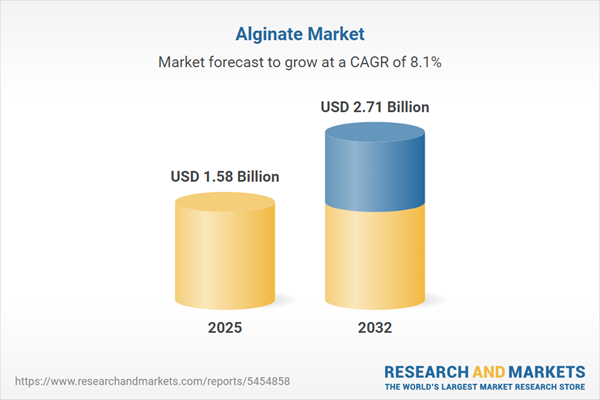Speak directly to the analyst to clarify any post sales queries you may have.
Senior executives in the sustainable materials space operate within a rapidly evolving environment defined by regulatory shifts, advancing process technology, and an increased focus on transparent, sustainable practices. As organizations pursue growth and resilience, the global alginate market represents a dynamic arena requiring agile adaptation and strategic foresight.
Market Snapshot: Global Alginate Market Size and Growth Trajectory
The global alginate market is projected to expand from USD 1.46 billion in 2024 to USD 2.71 billion by 2032, achieving a compound annual growth rate (CAGR) of 8.07%. Robust demand from the food, pharmaceutical, and manufacturing industries continues to drive market growth. Companies are innovating through technology upgrades, reinforcing compliance, and leveraging sustainable biomaterials as investor interest intensifies. To stay competitive, market participants must focus on transparency and the rapid adoption of strategies responsive to tightening industry standards.
Scope & Segmentation of the Global Alginate Market
A clear understanding of market segmentation supports executive decision-making and enhances overall operational effectiveness. The market encompasses several core domains:
- Forms: The market includes ammonium alginate, calcium alginate, potassium alginate, and sodium alginate, each designed to meet specific regulatory and application needs across industries.
- Functionalities: Alginate materials are valued for gelling, encapsulation, stabilization, film formation, and thickening properties, enabling manufacturers to create new products and sustain quality performance.
- Applications: These biomaterials are applied in construction materials, food and beverages, healthcare, cosmetics, textiles, and printing, each segment governed by distinct compliance, commercial, and supply chain requirements.
- Grades: Alginate is supplied in food, industrial, and pharmaceutical grades, ensuring targeted quality assurance for diverse end-uses and aligning with sector-specific standards.
- Regional Coverage: Key markets include the Americas, EMEA, and Asia-Pacific. Each region’s regulatory landscape, sourcing practices, and growth strategies require tailored market entry and expansion tactics.
- Leading Companies Profiled: Industry leaders such as Cargill, FMC Corporation, Algaia, Alginor ASA, JRS, Kimica, Ingredion, Gelymar, Qingdao Bright Moon Seaweed Group, and Ashland Global offer case studies in risk management and executive strategy implementation.
Key Takeaways for Senior Decision-Makers
- Sustainable procurement models are changing supply chain approaches, increasing organizational credibility and supporting adherence to shifting international benchmarks.
- Adoption of bioprocessing technologies positions companies to meet regulatory mandates efficiently and build robust compliance frameworks fit for future developments.
- Improved transparency and automation within manufacturing and logistics processes are driving operational improvements and strengthening quality standards across the market.
- Strategic investments in sourcing agility, advanced process technology, and collaborative innovation are helping mitigate risks from supply chain fluctuations and deliver measurable productivity gains.
- Distinct regional strategies have emerged: the Americas emphasize validated sourcing, EMEA prioritizes sustainable packaging, and Asia-Pacific leads in local process adaptations, each requiring a nuanced approach to competitive positioning.
Tariff Impact on Supply Chains and Market Strategy
Recent shifts in U.S. tariff policy are reshaping supply chain configurations for alginate producers. Many organizations are responding by enhancing domestic processing, sourcing more seaweed locally, and adopting nearshoring strategies. These measures allow companies to react nimbly to policy changes and bolster their market position amid ongoing regulatory interventions.
Methodology & Data Sources
This analysis draws on insights from industry interviews with cultivators, process engineers, and regulatory authorities, combined with a review of peer-reviewed literature, patent databases, and company disclosures. The market assessment utilizes frameworks such as SWOT, Porter’s Five Forces, and PESTEL to ensure a comprehensive evaluation aligned with executive priorities.
Why This Report Matters
- Enables executives to benchmark operational best practices and make data-driven strategic decisions in the global alginate sector.
- Supports effective anticipation of regulatory trends, advances in process technology, and localized supply chain strategies, helping organizations manage changing regional dynamics.
- Provides structured methodologies for agile risk analysis and scenario planning to address compliance and market evolution with confidence.
Conclusion
This report offers senior leaders an integrated, actionable overview of the global alginate market, equipping them to guide transformation, strengthen risk management, and improve operational resilience in an evolving industry landscape.
Additional Product Information:
- Purchase of this report includes 1 year online access with quarterly updates.
- This report can be updated on request. Please contact our Customer Experience team using the Ask a Question widget on our website.
Table of Contents
3. Executive Summary
4. Market Overview
7. Cumulative Impact of Artificial Intelligence 2025
Companies Mentioned
The companies profiled in this Alginate market report include:- Cargill, Incorporated
- FMC Corporation
- Algaia S.A.S.
- Alginor ASA
- J. Rettenmaier & Söhne GmbH + Co. KG
- Kimica Corporation
- Ingredion Incorporated
- Gelymar S.A.
- Qingdao Bright Moon Seaweed Group Co., Ltd.
- Ashland Global Holdings Inc.
Table Information
| Report Attribute | Details |
|---|---|
| No. of Pages | 189 |
| Published | November 2025 |
| Forecast Period | 2025 - 2032 |
| Estimated Market Value ( USD | $ 1.58 Billion |
| Forecasted Market Value ( USD | $ 2.71 Billion |
| Compound Annual Growth Rate | 8.0% |
| Regions Covered | Global |
| No. of Companies Mentioned | 11 |









